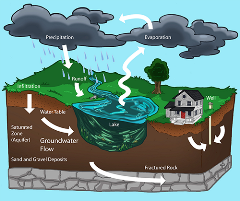 All the water of the Earth including the atmosphere, oceans, surface water, and groundwater participates in the natural system we call the hydrologic cycle. As water moves through all these elements repeatedly, the system is truly cyclical.
All the water of the Earth including the atmosphere, oceans, surface water, and groundwater participates in the natural system we call the hydrologic cycle. As water moves through all these elements repeatedly, the system is truly cyclical.
New water may be added to this system through volcanic activities; it is known as juvenile water. Water may also be taken out of the cycle through biological and chemical reactions.
Brief historical overview of the hydrologic cycle
Before the 17th century, many natural philosophers accepted the Greek theory (proposed by people who lived in a semiarid climate on limestone hills) that rainfall was insufficient to feed springs and rivers. It was thought that spring water was purified
sea water from deep within the earth (reverse osmosis?).
However, in 1580, Bernard Palissy (1510-1589) proposed the theory of the hydrologic cycle. Pierre Perrault (1608–1680) made careful observations of rainfall and streamflow in the Seine River basin, confirming Palissy's hunch and thus began
the study of modern scientific hydrology.
It should be noted that engineers and observers in the great arid civilizations from India to Egypt understood groundwater, occurrence, and movement at a much earlier date, as these societies relied upon irrigation and wells far more so than humid Europe. Recent revivals of writings by Varahamihira (6th century Indian) and Mohammed Karaji (10th century Persian) demonstrate this.
Groundwater's role in the hydrologic cycle
The fact that groundwater is tied in with the worldwide hydrologic cycle is well illustrated in the more arid regions of the United States. As the populations of such mild, dry-weather states as Arizona, New Mexico, Nevada, and
California grow, their water demands grow accordingly. Most of their people, from humid climates originally, take abundant water supplies for granted, and groundwater supplies of these states, as well as other booming but dry locations including the
Caribbean, Hawaii, and large regions of the developing world, are being severely strained. Groundwater in most of these regions is often stored water from more humid times, principally the Pleistocene glacial advances.
When water is drawn from these aquifers faster than the present meager rainfall can replenish it, this water in effect is being mined or depleted in the same way that petroleum is depleted. Here, the hydrologic cycle is upset: consumption (evaporation)
is greater than recharge (precipitation).
For the people of arid regions, water and its conservation will become the most important consideration in the further development of these areas. Even in humid localities, excessive consumption can upset the cyclic balance, as in northeastern Illinois
or the High Plains.
The fact that there is great concern in all these regions is encouraging, as there is certainly enough water, if managed properly. Management will inevitably mean reducing consumptive use to a level at or below the recharge rate.
The above information on the hydrologic cycle is excerpted in large part from Chapter 11 of the 1999 NGWA Press publication, Ground Water Hydrology for Water Well Contractors.